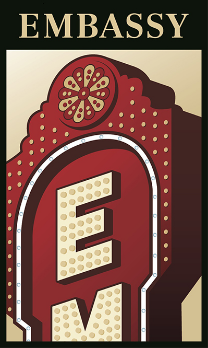On May 14, 1928, the doors of the magnificent Emboyd Theatre opened in Fort Wayne, Indiana. Built as a movie palace and vaudeville house, the Emboyd provided a majestic backdrop for the entertainment of the day, complete with a Grande Page theatre pipe organ. The Emboyd came complete with a seven-story, 250-room Indiana Hotel wrapped around the north and west sides of the theatre. Clyde Quimby, theater operator, had commissioned A.M. Strauss and John Eberson to design the Emboyd and the Indiana Hotel.
Vaudeville was at its height of popularity and the Emboyd featured acrobats, comedians, magicians and musicians. For nearly 25 years the biggest and brightest stars of stage and screen graced the Emboyd stage. Over time, television and “talkies” slowly eroded the popularity of silent films and vaudeville acts, the mainstay of the Emboyd. In 1952, the Emboyd Theatre and Indiana Hotel were sold to the Alliance Amusement Corporation. The name changed to the Embassy Theatre.
After the sale, the Embassy continued to operate as a movie palace. A small group of organ enthusiasts came together to become the unofficial guardians of the organ and its home, the Embassy Theatre.
During this time, the Embassy Theatre and the Grande Page held on while other theatres in downtown Fort Wayne succumbed to destruction. Times were changing and the Indiana Hotel was closed in 1971.
Faced with the wrecking ball in 1972, a handful of community leaders and volunteers, led by Robert Goldstine, banded together to form the nonprofit Embassy Theatre Foundation. Their goal was to protect the building for the good of the community and preserve the home of the Grande Page. Through the efforts of these volunteers and the support of a caring community, the successful “Save the Embassy” campaign raised the $250,000 necessary to rescue the building from demolition with just two days to spare.
After the building was saved, the work really began. Volunteers kept the Embassy alive by feeding coal bought with their own money into furnaces to keep the pipes from freezing. Efforts to fix the leaking roof and clean coal dust from the terra-cotta walls and lobbies continued.
In 1975, the Embassy was placed on the National Register of Historic Places. With the re-opening of the theatre, stars began appearing on the Embassy stage once again.
In 1985, the Embassadors, the former name for Embassy volunteers, established the first Festival of Trees. The initial festival raised $46,000, which was used to restore and renovate the front lobby entrances. The tradition of the Embassy Festival of Trees continues to this day as the Embassy’s signature fundraiser with more than 20,0000 patrons annually.
In 1995, a major renovation of the Embassy included expanding the stage to bring the theatre up to the modern standards required by large-scale touring companies. The theatre seats were upgraded, creating a seating capacity of 2,471. The renovation also included a facelift for the Indiana Hotel lobby and mezzanine, allowing the space to be used for social events. The renovation restored the stage and hotel to its former grandeur, once again making the Embassy the showplace of northern Indiana.
In 2016, the Embassy celebrated a $10 million renovation that opened all the previously closed building spaces, including former hotel floors that had been closed for nearly 40 years. The building now features a two-story ballroom with a rooftop patio, educational spaces and meeting rooms and administrative workspaces.
Today the Embassy features national artists, Broadway touring shows, concerts of all musical formats, cinema and educational programming.
With thanks to narrator Thomas Mathiesen, the Embassy proudly offers an audio-visual history of its first 90 years.

